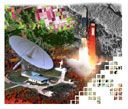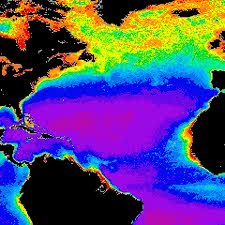
Fundamentals of Remote Sensing
2.13 Marine Observation Satellites/Sensors
The Earth's oceans cover more than two-thirds of the Earth's surface and play an important role in the global climate system. They also contain an abundance of living organisms and natural resources which are susceptible to pollution and other man-induced hazards. The meteorological and land observations satellites/sensors we discussed in the previous two sections can be used for monitoring the oceans of the planet, but there are other satellite/sensor systems which have been designed specifically for this purpose.
The Nimbus-7 satellite, launched in 1978, carried the first sensor, the Coastal Zone Colour Scanner (CZCS), specifically intended for monitoring the Earth's oceans and water bodies. The primary objective of this sensor was to observe ocean colour and temperature, particularly in coastal zones, with sufficient spatial and spectral resolution to detect pollutants in the upper levels of the ocean and to determine the nature of materials suspended in the water column. The Nimbus satellite was placed in a sun-synchronous, near-polar orbit at an altitude of 955 km. Equator crossing times were local noon for ascending passes and local midnight for descending passes. The repeat cycle of the satellite allowed for global coverage every six days, or every 83 orbits. The CZCS sensor consisted of six spectral bands in the visible, near-IR, and thermal portions of the spectrum each collecting data at a spatial resolution of 825 m at nadir over a 1566 km swath width. The accompanying table outlines the spectral ranges of each band and the primary parameter measured by each.
CZCS Spectral Bands
| Channel | Wavelength Range (mm) | Primary Measured Parameter |
|---|---|---|
| 1 | 0.43 - 0.45 | Chlorophyll absorption |
| 2 | 0.51 - 0.53 | Chlorophyll absorption |
| 3 | 0.54 - 0.56 | Gelbstoffe (yellow substance) |
| 4 | 0.66 - 0.68 | Chlorophyll concentration |
| 5 | 0.70 - 0.80 | Surface vegetation |
| 6 | 10.5 - 12.50 | Surface temperature |
 As can be seen from the table, the first four bands of the CZCS sensor are very narrow. They were optimized to allow detailed discrimination of differences in water reflectance due to phytoplankton concentrations and other suspended particulates in the water. In addition to detecting surface vegetation on the water, band 5 was used to discriminate water from land prior to processing the other bands of information. The CZCS sensor ceased operation in 1986.
As can be seen from the table, the first four bands of the CZCS sensor are very narrow. They were optimized to allow detailed discrimination of differences in water reflectance due to phytoplankton concentrations and other suspended particulates in the water. In addition to detecting surface vegetation on the water, band 5 was used to discriminate water from land prior to processing the other bands of information. The CZCS sensor ceased operation in 1986.
MOS
The first Marine Observation Satellite (MOS-1) was launched by Japan in February, 1987 and was followed by its successor, MOS-1b, in February of 1990. These satellites carry three different sensors: a four-channel Multispectral Electronic Self-Scanning Radiometer (MESSR), a four-channel Visible and Thermal Infrared Radiometer (VTIR), and a two-channel Microwave Scanning Radiometer (MSR), in the microwave portion of the spectrum. The characteristics of the two sensors in the visible/infrared are described in the accompanying table.
MOS Visible/Infrared Instruments
| Sensor | Wavelength Ranges (mm) | Spatial Resolution | Swath Width |
|---|---|---|---|
| MESSR | 0.51 - 0.59 | 50 m | 100 km |
| 0.61 - 0.69 | 50 m | 100 km | |
| 0.72 - 0.80 | 50 m | 100 km | |
| 0.80 - 1.10 | 50 m | 100 km | |
| VTIR | 0.50 - 0.70 | 900 m | 1500 km |
| 6.0 - 7.0 | 2700 m | 1500 km | |
| 10.5 - 11.5 | 2700 m | 1500 km | |
| 11.5 - 12.5 | 2700 m | 1500 km |
The MESSR bands are quite similar in spectral range to the Landsat MSS sensor and are thus useful for land applications in addition to observations of marine environments. The MOS systems orbit at altitudes around 900 km and have revisit periods of 17 days.
SeaWiFS
The SeaWiFS (Sea-viewing Wide-Field-of View Sensor) on board the SeaStar spacecraft is an advanced sensor designed for ocean monitoring. It consists of eight spectral bands of very narrow wavelength ranges (see accompanying table) tailored for very specific detection and monitoring of various ocean phenomena including: ocean primary production and phytoplankton processes, ocean influences on climate processes (heat storage and aerosol formation), and monitoring of the cycles of carbon, sulfur, and nitrogen. The orbit altitude is 705 km with a local equatorial crossing time of 12 PM. Two combinations of spatial resolution and swath width are available for each band: a higher resolution mode of 1.1 km (at nadir) over a swath of 2800 km, and a lower resolution mode of 4.5 km (at nadir) over a swath of 1500 km.
SeaWiFS Spectral Bands
| Channel | Wavelength Ranges (mm) |
|---|---|
| 1 | 0.402 - 0.422 |
| 2 | 0.433 - 0.453 |
| 3 | 0.480 - 0.500 |
| 4 | 0.500 - 0.520 |
| 5 | 0.545 - 0.565 |
| 6 | 0.660 - 0.680 |
| 7 | 0.745 - 0.785 |
| 8 | 0.845 - 0.885 |
These ocean-observing satellite systems are important for global and regional scale monitoring of ocean pollution and health, and assist scientists in understanding the influence and impact of the oceans on the global climate system.
| Updated2002-08-21 | Important Notices |